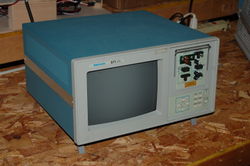571: Difference between revisions
(year per 1990 (Nov 1989) catalog) |
(template) |
||
| Line 1: | Line 1: | ||
The 571 is a curve tracer. It can show the characteristic curves of PNP and NPN bipolar transistors, both N- and P-channel FETs, diodes (including Zener types), and SCRs. It is a microprocessor-controlled device, and user interaction is done through navigation keys. A typical sweep run takes about five seconds. It has a parallel printer output that can print graphics on Epson-protocol dot-matrix printers. | {{Oscilloscope Sidebar | | ||
title=Tektronix 571 | | |||
summary=Curve tracer | | |||
image=Tek571_34_view.jpg | | |||
caption=Tektronix 571 Curve tracer | | |||
introduced=1989 | | |||
discontinued=1995 | | |||
manuals= | |||
* [http://w140.com/tek_571.pdf Tektronix 571 Manual (PDF)] | |||
}} | |||
The '''Tektronix 571''' is a curve tracer. It can show the characteristic curves of PNP and NPN bipolar transistors, both N- and P-channel FETs, diodes (including Zener types), and SCRs. It is a microprocessor-controlled device, and user interaction is done through navigation keys. A typical sweep run takes about five seconds. It has a parallel printer output that can print graphics on Epson-protocol dot-matrix printers. | |||
One nice feature of the 571 is its ability to store a set of ''reference'' curves, which are displayed as a background for subsequent measurement runs. This makes comparison and matching between devices easy. | One nice feature of the 571 is its ability to store a set of ''reference'' curves, which are displayed as a background for subsequent measurement runs. This makes comparison and matching between devices easy. | ||
| Line 7: | Line 17: | ||
Because the nature of electronic component testing involves exposing components to sometimes hazardous voltages and operating conditions, at certain settings the 571 will refuse to start a measurement cycle until the user lowers the built-in hinged plastic shield over the socket area. This is to protect the user from both high voltage and high-velocity flying debris in the event of a catastrophic component failure during a test run. The shield is made of a thick high-impact plastic, and the 571 has an internal microswitch so its firmware knows if the shield is in the up or down position. | Because the nature of electronic component testing involves exposing components to sometimes hazardous voltages and operating conditions, at certain settings the 571 will refuse to start a measurement cycle until the user lowers the built-in hinged plastic shield over the socket area. This is to protect the user from both high voltage and high-velocity flying debris in the event of a catastrophic component failure during a test run. The shield is made of a thick high-impact plastic, and the 571 has an internal microswitch so its firmware knows if the shield is in the up or down position. | ||
==Specifications== | |||
[[Category:Specifications needed]]''please add'' | |||
==Pictures== | ==Pictures== | ||
| Line 25: | Line 36: | ||
[[Category:Curve tracers]] | [[Category:Curve tracers]] | ||
Revision as of 03:29, 29 August 2014
The Tektronix 571 is a curve tracer. It can show the characteristic curves of PNP and NPN bipolar transistors, both N- and P-channel FETs, diodes (including Zener types), and SCRs. It is a microprocessor-controlled device, and user interaction is done through navigation keys. A typical sweep run takes about five seconds. It has a parallel printer output that can print graphics on Epson-protocol dot-matrix printers.
One nice feature of the 571 is its ability to store a set of reference curves, which are displayed as a background for subsequent measurement runs. This makes comparison and matching between devices easy.
The 571 has a well-designed field of parallel-connected sockets to accommodate many different semiconductor package types. Details can be seen in the photographs below.
Because the nature of electronic component testing involves exposing components to sometimes hazardous voltages and operating conditions, at certain settings the 571 will refuse to start a measurement cycle until the user lowers the built-in hinged plastic shield over the socket area. This is to protect the user from both high voltage and high-velocity flying debris in the event of a catastrophic component failure during a test run. The shield is made of a thick high-impact plastic, and the 571 has an internal microswitch so its firmware knows if the shield is in the up or down position.
Specifications
please add
Pictures
-
571, front 3/4 view
-
571, rear view
-
571, measurement head, shield up
-
571, measurement head, shield down
-
571, parameters screen
-
571, run of a 2N2222A transistor
-
571, run of a 1N3020B 10V Zener diode
-
571, inside view
-
571, inside view, closeup of socket board
-
571, inside view, closeup of relays










